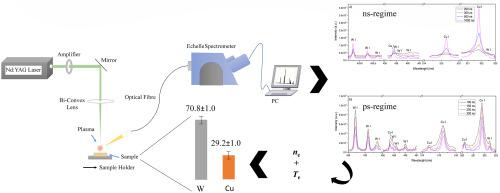Spectrochimica Acta Part B: Atomic Spectroscopy ( IF 3.2 ) Pub Date : 2020-12-24 , DOI: 10.1016/j.sab.2020.106055 Alicia Marín Roldán , Matej Pisarčík , Matej Veis , Milan Držík , Pavel Veis

|
The elemental analysis of plasma-facing components (PFCs) with deposits is vital for the study of the material erosion, deposition, and fuel retention. For ITER-like divertor, first wall is formed by W-based deposit containing Be, O, D, H and other impurities. The quantification of fuel retention in these materials, including the depth dependence of the fuel retention and the elemental composition, is important. Calibration free laser-induced breakdown spectroscopy (CF-LIBS) is the only technique possible for online remote diagnostics with recognition of the hydrogen isotopes. But the most commonly used ns-LIBS leads to material's overheating; thus, larger non-realistic retention of hydrogen isotopes is generally obtained. In this work, we report the quantitative ps- and ns-CF LIBS analysis of W-based model material (WCu). A WCu alloy has been selected to permit the analysis of tungsten spectral lines in a binary alloy with an element with not too many weak lines. Surface experiments are performed by LIBS using ~30 ps and 5 ns, 1064 nm laser pulses at atmospheric pressure. One of the advantages of ps laser is that it ablates the surface more efficiently, without overheating the ablated material. The laser ablation threshold for the plasma creation in the ps regime is situated at lower energy, thus less material is needed and better depth resolution can be obtained. Suitable Cu and W spectral lines have been selected for the precise evaluation of the electron temperature using the Saha-Boltzmman plots. The electron density values were found from the Saha-Boltzmann plots and the Stark broadening of the Hα spectral line. The results demonstrate the successful detection of W and Cu spectral lines using ps- and ns-LIBS and its quantification.
中文翻译:

钨基靶材的无标定分析,用于比较皮秒和纳秒级LIBS的相关融合材料的诊断
具有沉积物的面向等离子体的组分(PFC)的元素分析对于研究材料腐蚀,沉积和燃料保留至关重要。对于类似ITER的偏滤器,第一壁由含Be,O,D,H和其他杂质的W基沉积物形成。这些材料中燃料保留量的量化,包括燃料保留量和元素组成的深度依赖性,很重要。无标定激光诱导击穿光谱法(CF-LIBS)是唯一可以在线识别氢同位素的远程诊断技术。但是最常用的ns-LIBS会导致材料过热。因此,通常会获得更大的氢同位素非现实保留。在这项工作中,我们报告了基于W的模型材料(WCu)的定量ps和ns-CF LIBS分析。选择了WCu合金以允许分析二元合金中钨光谱线,其中元素的弱线不太多。LIBS使用大气压下的〜30 ps和5 ns,1064 nm激光脉冲进行表面实验。ps激光的优点之一是它可以更有效地烧蚀表面,而不会使烧蚀的材料过热。ps模式下用于等离子体产生的激光烧蚀阈值处于较低能量下,因此需要的材料更少,并且可以获得更好的深度分辨率。已使用Saha-Boltzmman图选择了合适的Cu和W谱线来精确评估电子温度。电子密度值可从Saha-Boltzmann图和H的Stark展宽中找到α谱线。结果表明,使用ps-和ns-LIBS成功进行了W和Cu谱线的检测及其定量。










































 京公网安备 11010802027423号
京公网安备 11010802027423号